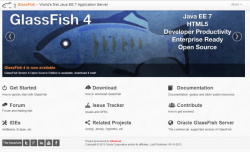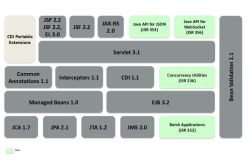Java EE 7 reference implementation GlassFish 4.0 released

![]() The GlassFish web site has been freshened up and, unlike its previous incarnation, looks very tidy
The GlassFish web site has been freshened up and, unlike its previous incarnation, looks very tidy
With the Java Community Process (JCP) committee responsible for Java EE 7 having signed off Java EE 7 in April, Oracle has now added a reference implementation for the specification in the form of GlassFish 4.0. Following 89 "promoted builds" and a good 20 months of development, the next major version of the Java application server is therefore now finished. By its nature, the open source GlassFish is the first server compatible with the enterprise Java standard. In contrast, the number of application servers compatible with the previous version of the standard – Java EE 6 – now exceeds ten.
Given that Oracle has invested some time and marketing effort in the official Java EE 7 launch, due to take place on Wednesday, it would appear that the launch of the new, tidier-looking GlassFish server web site yesterday evening was premature. Signs of this are also apparent on the support site for the IDE. The site contains a link to version 7.3.1 of development environment NetBeans, despite the fact that it has not yet been released. Information on Oracle commercial services for the new version of GlassFish are also yet to appear on the Oracle Technology Network (OTN).
With the official GlassFish bug tracker still showing some bug-fixes which have clearly not made it into the new version, GlassFish 4.0.1 should be expected relatively soon. The directory for future "promoted builds" has already been created and, after tomorrow, is sure to start filling up.

![]() The key changes in Java EE 7 at a glance
The key changes in Java EE 7 at a glance
Java Enterprise Edition 7 is the first version for which Oracle is completely responsible, with the previous version dating from the Sun era. Both are umbrellas for a wide range of individual technologies and provide a basic set of rules for how these technologies interact. In addition to the 28 included in Java EE 6, four specifications are completely new. Major changes justifying a major version increment were also made to the content of three existing specifications. Changes to the remaining specifications have been largely cosmetic.
New features include APIs for working with popular web technologies. As well as fully-fledged specifications such as WebSockets (JSR 356) and JSON (JSR 353), HTML5 support has been integrated into JavaServer Faces (JSF) and the platform also takes up the issue of batch processing. JSR 352 standardises a programming model for batch applications and provides a runtime environment for planning and executing jobs. Concurrency utilities permit better access to container resources and mean that Java EE is now able to use threads more reliably and in synchronicity with containers.
(Markus Eisele / fab)








![Kernel Log: Coming in 3.10 (Part 3) [--] Infrastructure](/imgs/43/1/0/4/2/6/7/2/comingin310_4_kicker-4977194bfb0de0d7.png)

![Kernel Log: Coming in 3.10 (Part 3) [--] Infrastructure](/imgs/43/1/0/4/2/3/2/3/comingin310_3_kicker-151cd7b9e9660f05.png)








